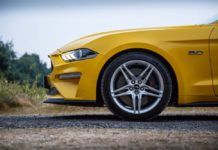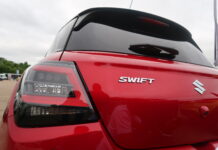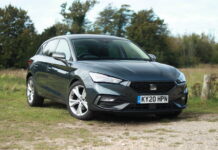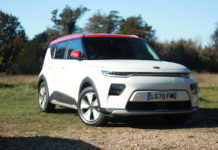Recently I tested the new Ford Fiesta automatic and although it was a decent car, its automatic gearbox held the car back in my opinion. Straight from the back of that Fiesta, I was given another one to try out, which has the six-speed manual. As well as a different gearbox, the model tested here also has a different engine – the 1.5 litre diesel. Oh, the colour is different too of course – the exclusive ‘Blue Wave’ which will cost you £745. It’s not the most manly colour, but it’s rather nice all the same.

Like the last model tested, this is a mid-range Titanium model, which has almost the same optional extras, so for that reason I will not cover the kit extensively here as that was done on my previous review. But to summarise, the Titanium gives you LED daytime running lights, 16″ alloys, leather steering wheel, 8″ touchscreen infotainment system with navigation, climate control, cruise control and automatic lights and wipers to name a few.
***If you want the full lowdown on the new Fiesta, check out my previous review as this one is focusing on the diesel engine and the six speed manual***

This model would normally cost you £18,525, but with the options added, you’re looking at over £21,000, which will not be to everyone’s budget of course. Having said that, I think the B&O Play system is really worth having as well as the park assistance program. The panoramic roof is nice, but it does cut in to the headroom in the back, so I’m not sure I would spec that on a Fiesta, nor would I spec the 17″ alloys as the road noise is more noticeable and the ride isn’t quite as good.

What’s The Diesel Like?
The new generation Fiesta is not the first to be offered with a diesel engine, but it almost feels like the lost relation, thanks to the popularity of the EcoBoost engine. The 1.5 litre diesel has been refined for the new model, but even so, Ford predicts that only 9% of the market will opt for this engine, with the majority of those being fleet buyers. The engine itself is available with two power outputs – 84bhp and 118bhp.

The 84bhp comes with 215Nm of torque and will be able to get to 62mph in 12.5 seconds and it will run out of puff at 108mph. The 118bhp on the other hand, comes with 270Nm of torque, meaning it has an improve 0-62 time of 9 seconds dead and the top speed is 121mph. Both gearboxes are mated to a 6-speed manual gearbox as the automatic is only available with the EcoBoost unit.
At this point I’m not afraid to admit that I thought putting a diesel in to a Fiesta was about as exciting as watching paint dry, but it actually works quite well. The power comes in at around 1,500 revs and thanks to a good level of mid-range grunt, the Fiesta feels like a bigger car than it actually is. It also makes overtaking a doodle and because it has 6 speeds in its manual repertoire, it will cruise very nicely on the motorway.

Speaking of which, just how refined is the diesel engine? Does it clatter? Does it rattle? Is is about as enticing as a canal boat? The answer to this is no, it’s a smooth engine that isn’t too noisy although it does become a bit boomy at the top of the rev range, but even then it won’t attack your earhdrums like a vuvezela that’s in the possession of Brian Blessed. Blimey, can you imagine such a thing? Let’s move on.
At cruising speed it will work away quietly in the background and the only thing you’ll be able to hear is the road noise coming of the larger, optional alloys. This leaves you to enjoy what the Fiesta has to offer, which is a fair bit. Having the manual in place of the automatic makes a vast improvement to driving dynamics and the car is simply more engaging. The 6-speed has a nice slick action to it and although it’s got a nice weight to it, but you’ll still be able to change gear by merely flicking the gearstick with a few fingers.

I covered the handling, etc. in my other review, but to summarise, the Fiesta is a delight to drive, even more so with the manual. ‘Dynamic’ is a word I’ve used with almost overkill amounts when it comes to the new Fiesta, but its worthy of this persistent praise.
From a driver’s point of view, ever component simply feels ‘right’ all the way from the feel of the pedals to the weight of the steering. Like its predecessor, it handles well and the chassis has a nice balance to it. As well as offering a decent weight, the steering is direct and responsive too, which puts the forthcoming ST in good stead.

What About The Economy?
One of the main reasons for opting for the diesel in the new Fiesta will of course be economy. With this being the more powerful engine, the economy is a little lower. 80.7mpg is what you can expect on a combined run and in my experience I was getting around 70. 89g/km of CO2 emissions is emitted from this engine, which puts it in VED tax band D, so you’ll pay £100 for the first year of road tax.
This model has a BIK percentage of 20% for the first year, 22% for the second and 25% for the third. In regards to less powerful diesel, that offers a combing mpg figure of 88.3 in three-door guise and 85.6 in five door guise. The CO2 emissions differ as well – 82g/km is offered in the three whilst 84g/km is offered in the five door model.
Final Thoughts
I honestly thought a diesel engine would really take the fun out of the Fiesta but I have been proven wrong. Sure it won’t be as exciting as the fizzy and eager EcoBoost engine, but the diesel is a worthy engine choice. Despite this, it won’t be the most popular choice thanks to the success of the aforementioned EcoBoost. But, if you’re looking for a supermini with a decent diesel engine the Fiesta is definitely worth looking at.














